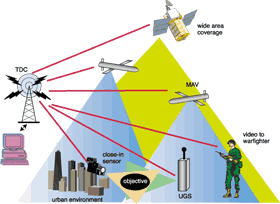fortress urbanism: Super Bowl City (Detroit)

[Image: Thermal Imaging Day & Night Observation System (DANOS), Military & Law Enforcement Technologies]
According to USA Today, the U.S. Postal Service removed mailboxes this week from the downtown area near Ford Field Stadium, where today's Super Bowl XL football game will be played. Fans should expect to be checked by explosives-sniffing dogs, patted down, and scanned by metal detectors. The city banned parking in the central business district to make room for crowds of at least 65,000 people, prevent car bombings and keep roads clear for ambulances and police. Coast Guard dive teams and patrol boats are covering areas near the waterfront that are hosting Super Bowl parties. And some Canadian border enforcement officers have been deputized so they can make arrests on either side of the border. "There are unique challenges to do a security operation with another country literally in view," says Marc Raimondi, spokesman for U.S. Immigration and Customs Enforcement (ICE).
The Department of Homeland Security didn't designate the Super Bowl a "National Special Security Event," which, as the USA Today article indicated, "would (have) trigger(ed) the use of radiation detectors, biological sensors and other tight security measures. In the post-9/11 era, such security generally is reserved for events such as a presidential inauguration."

[Image: SPT: Distributed Sensor Network for Real Time Tracking, University of Massachusetts Dept. of Computer Sciences]
But, Slashdot points out in another article, Michigan National Guard troops will be patrolling the stadium and nearby neighborhoods with handheld computers and special sensors tied together in a uniform system to fight any number of threats. A first for the Super Bowl, "Members of the MNG will deploy 'sensor fusion', a real-time, IP-based wireless technology that combines readings from portable and fixed devices that can potentially detect terrorist threats. While sensors capable of detecting chemical, biological, or radiological threats have been used at previous Super Bowls, the readings had to be communicated by radio between different security personnel. Sensor fusion automatically takes readings from the devices and uploads them to a central, secure Web server, where security staff anywhere can monitor conditions at the event." Part of the emerging realm of virtualized battle space innovation that is sort of landscaping an open-source evolution of a more network-centric-warfare system.

[Image: battlefield situational awareness, Surveillance Gives the Big Picture by Christopher Durso, OE Magazine]
Add to that, downtown Detroit is crawling with hundreds of security forces and is being watched by as many surveillance cameras, if not more. Get this, Sprint-Nextel has even installed brand new fiber optics permanently for the event. And, with Canadian CF-18's and a mess of American F-16's patrolling the skies, enforcing a 50 km "no-fly" zone around Ford Field, Super Bowl City (synonymous with Super Bowl Sunday - the most globally televised event in history every year) could, for a day, overtake London as the most watched city in the world. Detroit, overnight becomes an instant battle city seen by everyone. A nomadic capital for an excercise in U.S. deployed fortress urbanism; a Rumsfeldian monument to the commercialization of the spectacle of war. Fort Field, in a matter of hours, turns into a spontaneous and controlled past-time riot town, a fortified urban temple designed for such abuse. Of course, it's also the ultimate training center for the Department of Homeland Security; the football stadium as the ideal city waiting for attack. Regardless, today could be, perhaps, the most militarized day in Detroit's history. That's a little spooky.
If that doesn't convince you, all 120 Super Bowl footballs have been marked with a drop of synthetic DNA, detectable with lasers, to prevent frauds from selling fake game-used footballs afterwards for big money.
1 Comments:
One I missed: Holograms help protect Super Bowl
"The U.S. government will deploy a new "Star Wars-like" hologram technology to help safeguard the Super Bowl on Sunday.
LifeVision uses streams from two cameras, which act as the left and right eyes, to project 3D images onto a 20-inch screen. The monitors used are equipped with a depth tube that presents images that appear to rise 30 inches from the screen and sink another 30 inches into the screen, Fischbach said. Real-world volumes and distances are displayed accurately.
No special goggles or glasses are needed. "For the military, it can offer much better facial recognition," Fischbach said. "Instead of looking at a two-dimensional photo, you're looking at an entire head."
via Defense Tech
Post a Comment
<< Home